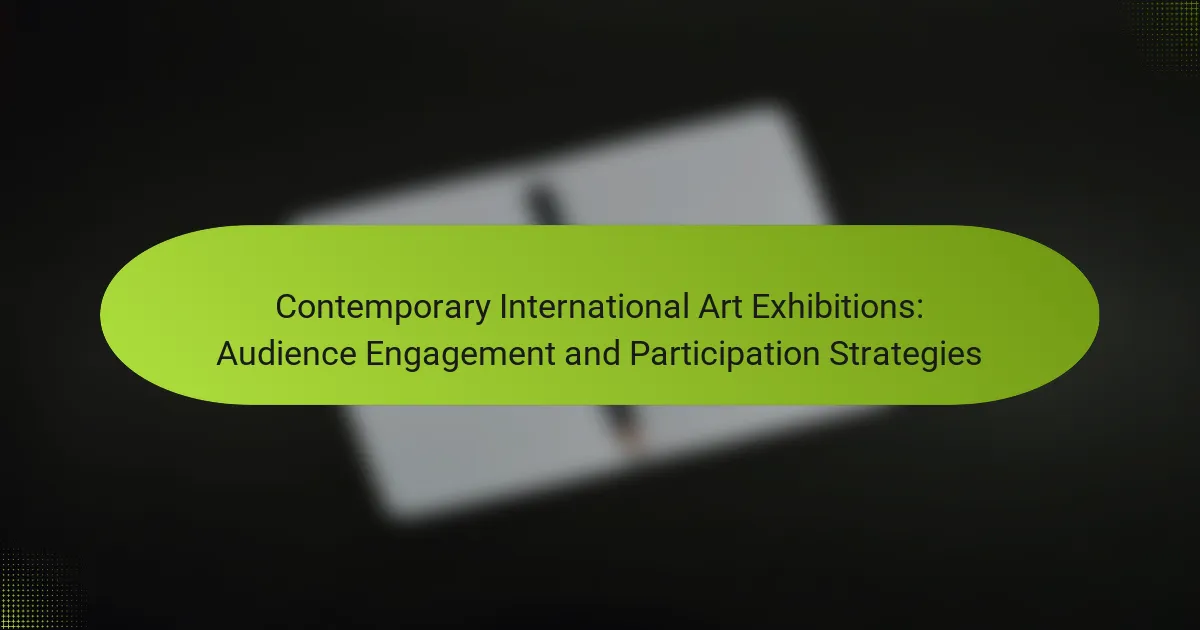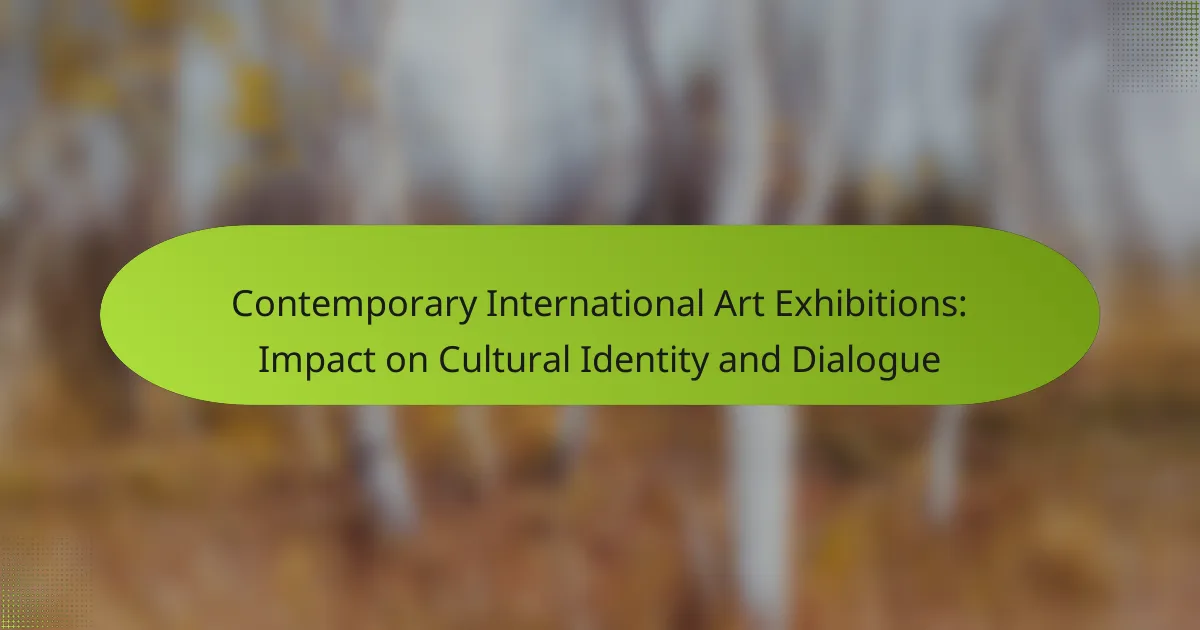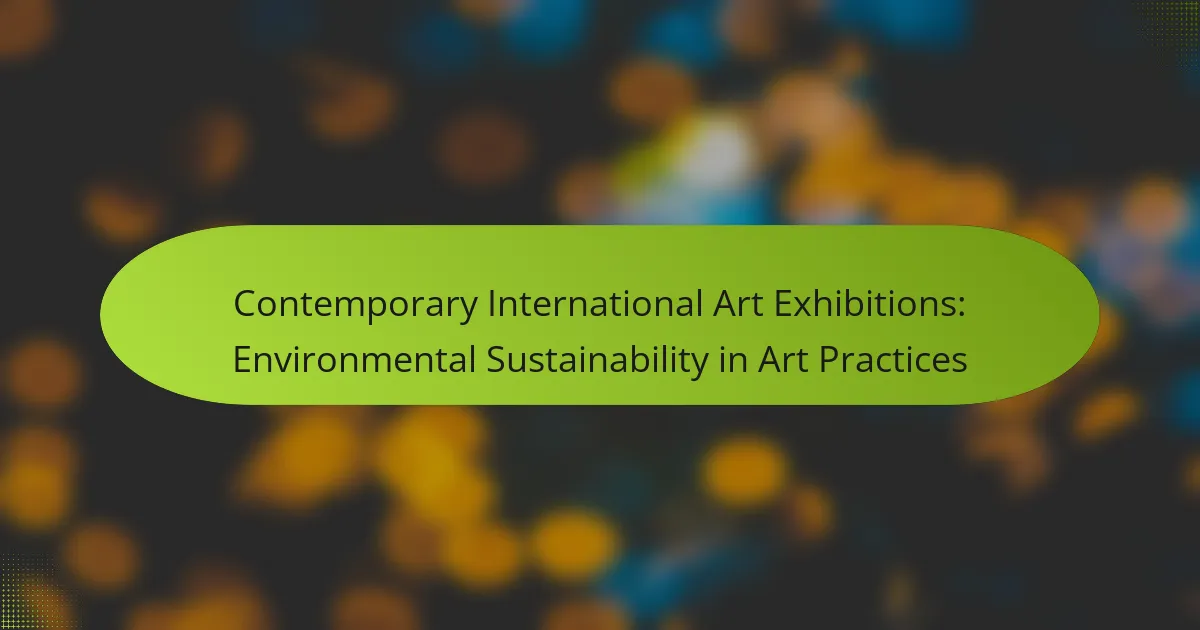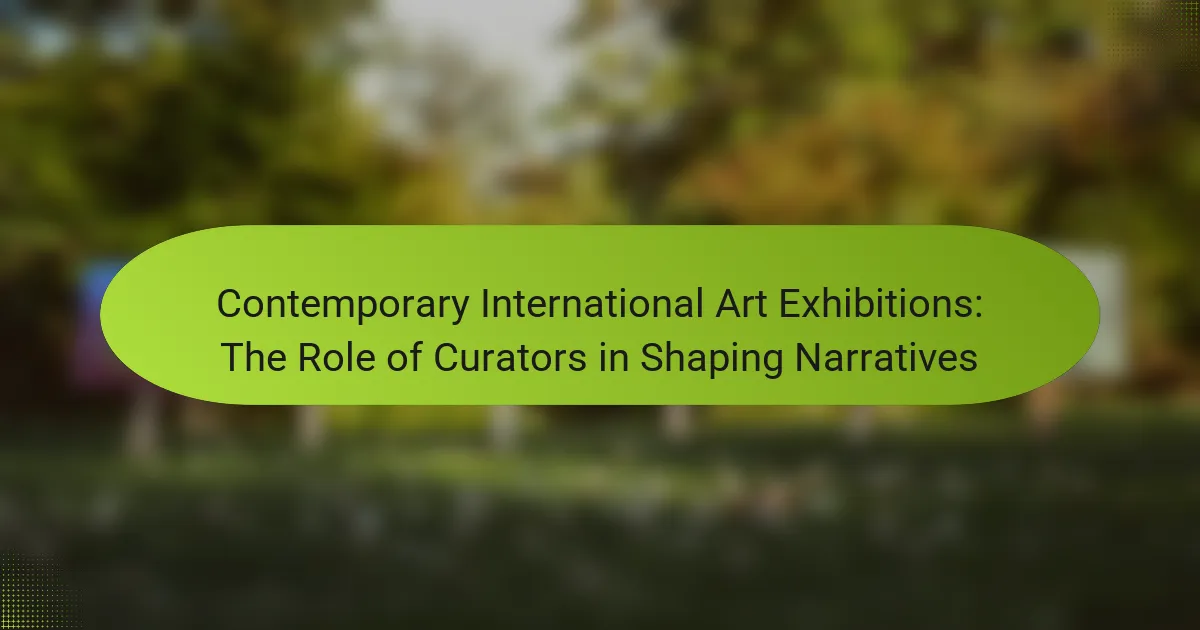Contemporary international art exhibitions are transforming the global art market, driven by trends in digital engagement and sustainability. This article explores the rise of art fairs, the focus on underrepresented artists, and the crucial role of galleries. It also addresses the challenges of cultural differences and economic disparities while highlighting how collectors can navigate this evolving landscape.
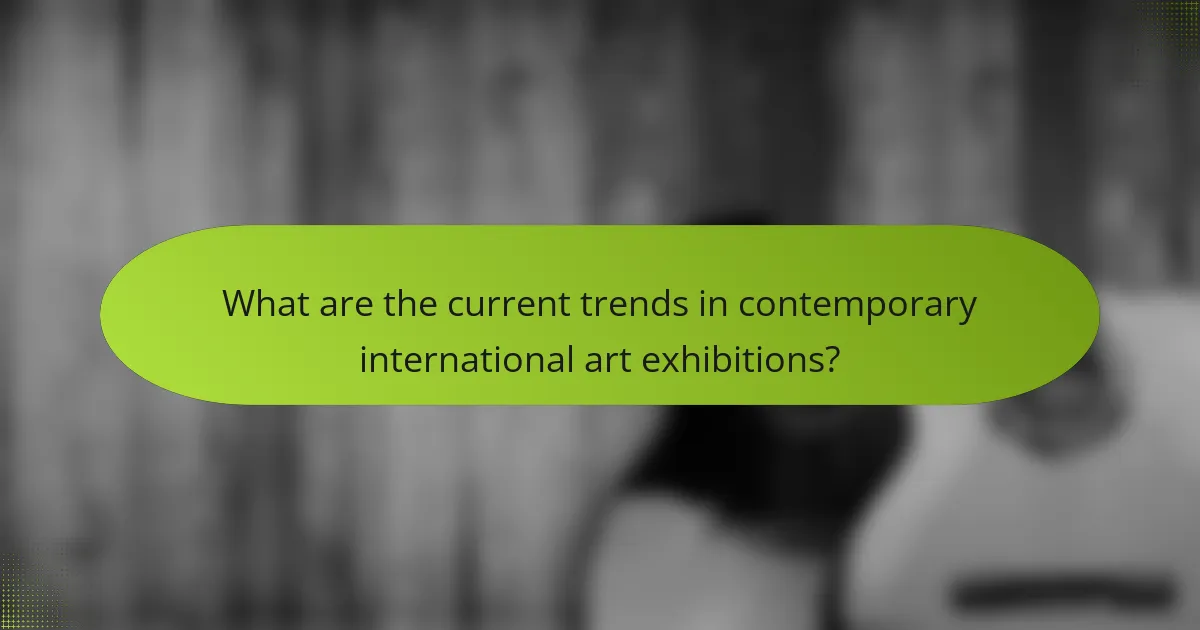
What are the current trends in contemporary international art exhibitions?
Current trends in contemporary international art exhibitions include increased digital engagement, focus on social issues, and diverse representation. Art fairs are expanding globally, with more cities hosting significant events. Many exhibitions now integrate technology, enhancing viewer interaction through virtual reality and augmented reality experiences. Additionally, sustainability is becoming a priority, influencing both the themes of the art and the materials used in installations. Collectors are increasingly interested in emerging artists, reflecting a shift towards inclusivity and innovation in the global art market.
How do digital platforms influence art exhibition attendance?
Digital platforms significantly enhance art exhibition attendance by increasing visibility and accessibility. Online marketing strategies, social media engagement, and virtual tours attract diverse audiences. For instance, exhibitions that utilize Instagram and Facebook often see higher visitor numbers due to targeted promotions. Additionally, digital platforms facilitate global reach, allowing art enthusiasts from various regions to participate in exhibitions they might otherwise miss. This trend reflects a shift in the global art market, where online presence is crucial for attracting collectors and visitors alike.
Which themes are dominating global art exhibitions in 2025?
In 2025, global art exhibitions will prominently feature themes of sustainability, technology integration, and social justice. These themes reflect contemporary societal issues and resonate with diverse audiences.
Sustainability in art emphasizes eco-friendly practices and materials. Artists explore environmental concerns through innovative installations and multimedia works. Technology integration showcases digital art and virtual reality, enhancing audience engagement. Social justice themes address inequality and human rights, fostering dialogue and awareness.
These trends indicate a shift towards art as a platform for activism and community involvement, shaping future exhibitions.
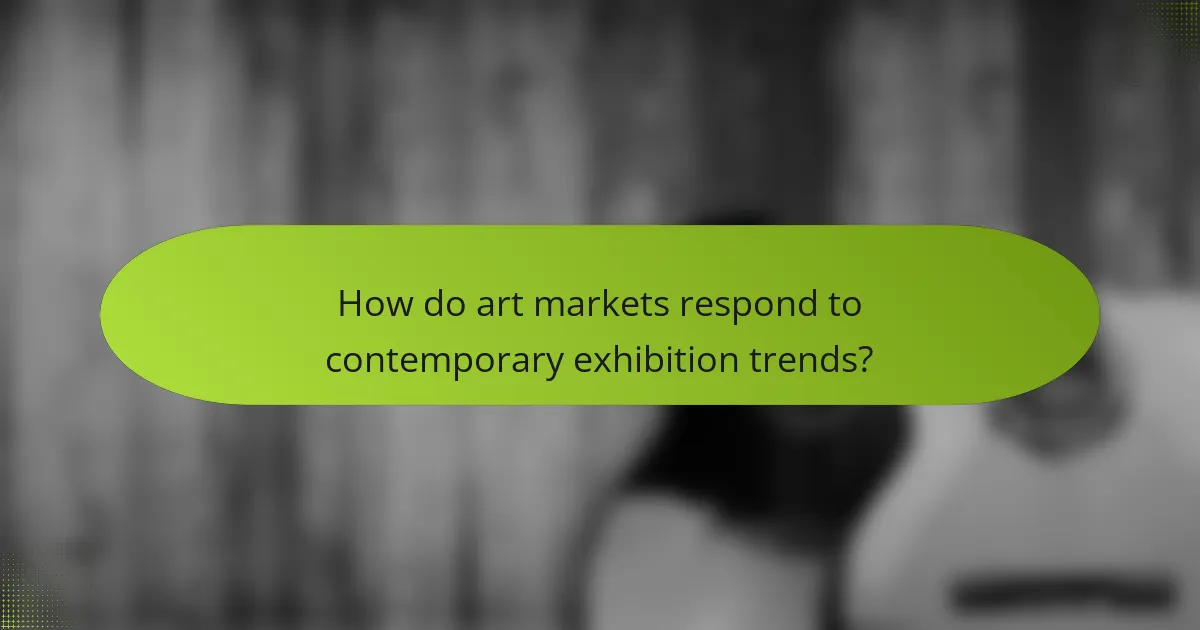
How do art markets respond to contemporary exhibition trends?
Contemporary art markets are increasingly responsive to trends in global exhibitions. They adapt by emphasizing digital engagement, diversifying collector demographics, and prioritizing sustainability. For instance, online sales surged by 25% in 2021, reflecting a shift towards virtual platforms. Additionally, exhibitions now often showcase underrepresented artists, enhancing market inclusivity. This responsiveness indicates a dynamic interplay between exhibition trends and market evolution.
What factors drive pricing in international art markets?
Pricing in international art markets is driven by factors such as artist reputation, market demand, rarity, and economic conditions. Artist reputation significantly influences perceived value, while demand can fluctuate based on trends and collector interest. Rarity of artworks often enhances pricing, as limited availability increases desirability. Additionally, broader economic conditions, including currency fluctuations and global market stability, play a crucial role in pricing dynamics.
How does the collector demographic influence exhibition styles?
Collector demographics significantly shape exhibition styles by influencing themes, presentation formats, and audience engagement. Younger collectors often favor immersive experiences and interactive installations, while established collectors may prefer traditional formats showcasing established artists. Regional preferences also emerge, with local collectors supporting culturally relevant exhibits. Trends indicate a growing interest in sustainability, prompting exhibitions to incorporate eco-friendly practices. This demographic shift drives curators to adapt and innovate, aligning with collectors’ values and interests to enhance the overall art market experience.
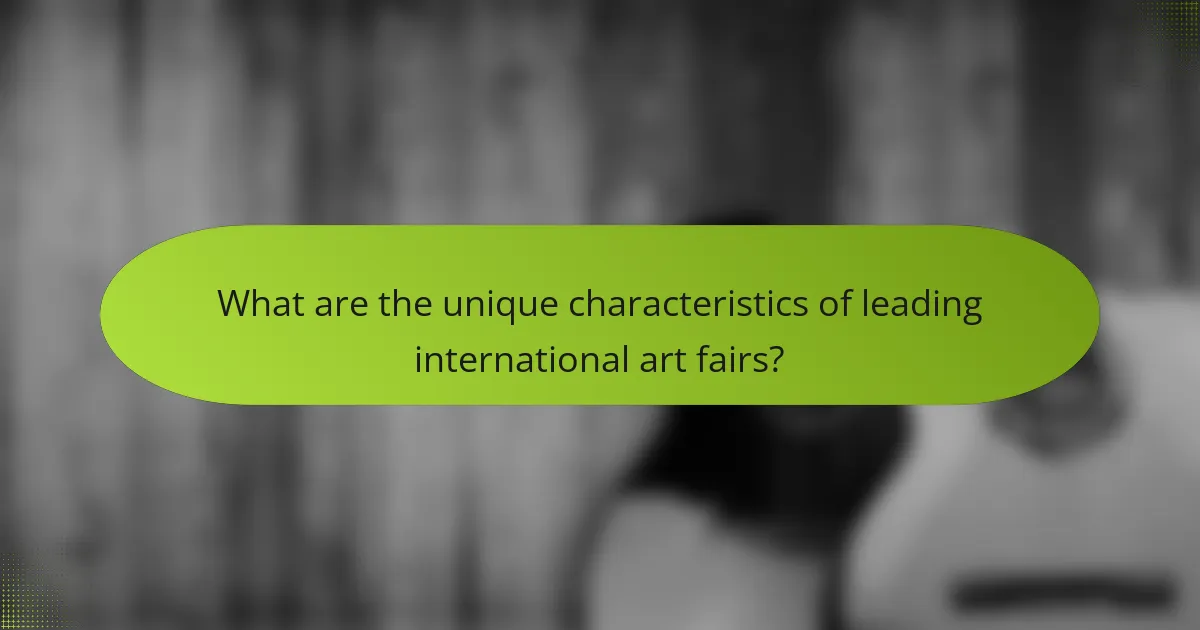
What are the unique characteristics of leading international art fairs?
Leading international art fairs are distinguished by their diverse programming, global participation, and innovative presentation methods. They showcase a wide range of contemporary art, attracting collectors and enthusiasts alike. Key characteristics include a strong emphasis on emerging artists, interactive installations, and curated exhibitions that reflect current trends in the global art market. Notably, these fairs often integrate technology, enhancing visitor engagement through virtual tours and digital platforms. Additionally, their ability to foster international dialogues on art and culture sets them apart, creating a unique space for networking and collaboration among artists, galleries, and collectors.
Which art fairs are considered must-visit events in 2025?
The must-visit art fairs in 2025 include Art Basel, Frieze Art Fair, and The Armory Show. These events showcase cutting-edge contemporary art and attract global collectors.
Art Basel takes place in multiple locations, including Miami Beach and Hong Kong, emphasizing premier galleries and emerging artists. Frieze Art Fair, held in London and New York, is known for its curated exhibitions and innovative installations. The Armory Show, located in New York City, focuses on modern and contemporary art, featuring a diverse range of artists and galleries.
These fairs represent significant trends in the global art market, offering insights into collecting and investment opportunities. Collectors and art enthusiasts can explore unique artworks and engage with leading figures in the art world.
How do regional cultural influences shape art fair presentations?
Regional cultural influences significantly shape art fair presentations by reflecting local values, aesthetics, and historical contexts. These exhibitions often showcase artists and artworks that resonate with the cultural narratives of their regions. For instance, Asian art fairs frequently emphasize traditional techniques alongside contemporary practices, highlighting the blend of heritage and modernity.
Moreover, regional themes can dictate the selection of featured artists, influencing trends in the global art market. Art fairs in Europe may focus on conceptual art, while those in Africa often celebrate community-driven projects that address social issues. This diversity enriches the art fair landscape, fostering cross-cultural dialogue and expanding collectors’ perspectives.
As a result, understanding these influences can enhance the experience for attendees and collectors, enabling them to appreciate the nuances of global art trends.
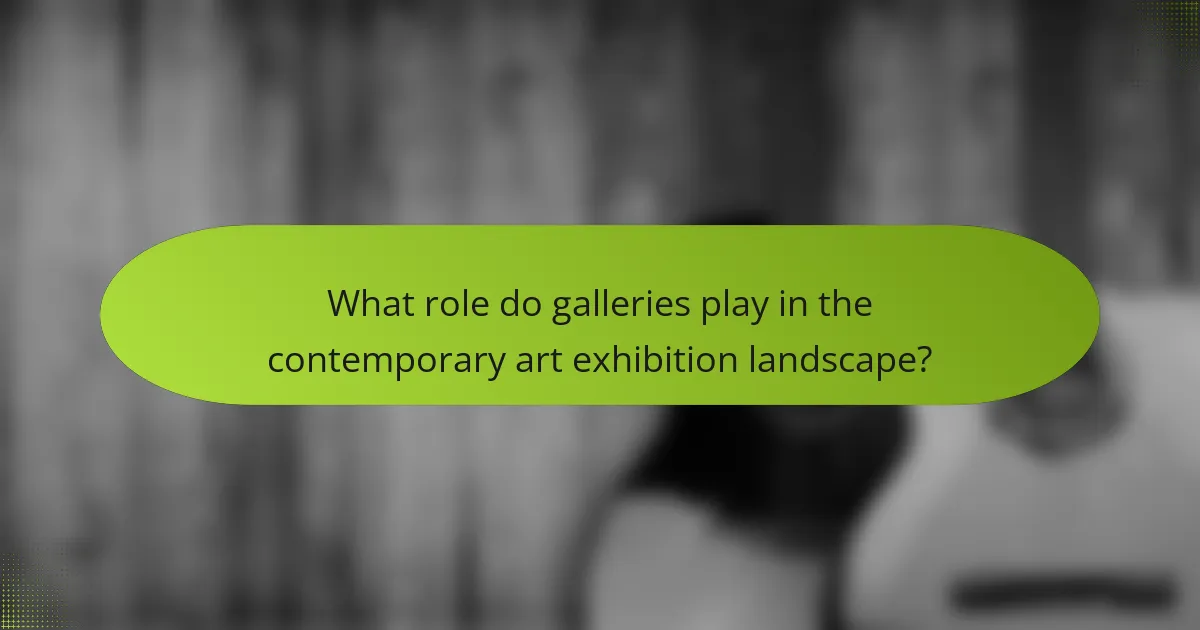
What role do galleries play in the contemporary art exhibition landscape?
Galleries play a crucial role in shaping contemporary art exhibitions by connecting artists with collectors and audiences. They serve as platforms for emerging and established artists, facilitating exposure and engagement.
Galleries curate exhibitions that reflect current trends in the global art market, enhancing visibility for artworks and fostering dialogue among diverse artistic voices. They also provide essential support in logistics, marketing, and sales, which are vital for the success of art exhibitions.
In addition, galleries often collaborate with institutions and other galleries, creating networks that amplify the impact of exhibitions. This interconnectedness helps sustain the contemporary art ecosystem, influencing collecting behaviors and market dynamics.
As a result, galleries not only exhibit art but also contribute to the cultural and economic landscape of contemporary art, shaping trends and preferences in global art markets.
How are galleries adapting to changes in collector behavior?
Galleries are adapting to changes in collector behavior by leveraging digital platforms and enhancing engagement. Many galleries now offer virtual exhibitions, allowing collectors to explore art from anywhere. They are also focusing on personalized experiences, such as tailored recommendations based on collectors’ preferences. Additionally, galleries are utilizing social media to reach younger audiences, fostering community interaction and driving sales. As a result, galleries are becoming more accessible and responsive to evolving market dynamics.
What partnerships are forming between galleries and digital platforms?
Galleries are increasingly partnering with digital platforms to enhance visibility and accessibility. These collaborations facilitate virtual exhibitions, expanding audience reach beyond physical locations. For instance, galleries are leveraging social media and online marketplaces to showcase artworks, engage collectors, and drive sales. This trend reflects a shift in the global art market, where digital presence is becoming essential for contemporary art exhibitions.
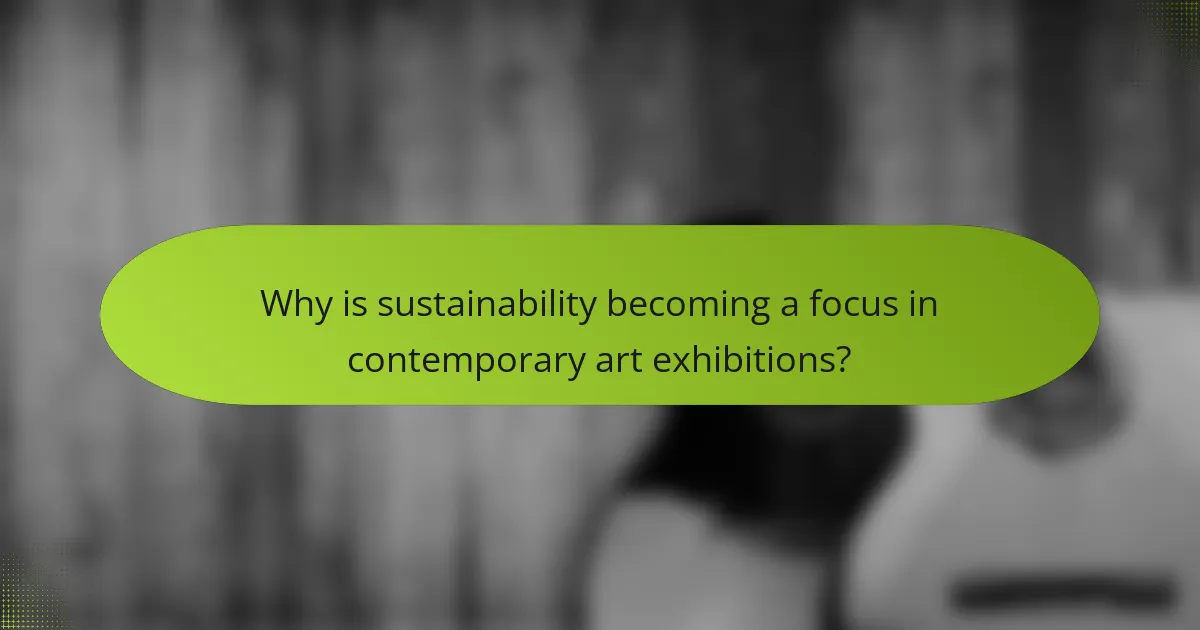
Why is sustainability becoming a focus in contemporary art exhibitions?
Sustainability is becoming a focus in contemporary art exhibitions due to growing environmental awareness. Artists and curators prioritize ecological themes to engage audiences and promote social responsibility. This trend reflects a unique attribute of contemporary art, where practices increasingly integrate sustainability into their core message. As a result, exhibitions often feature recycled materials and socially conscious artworks, fostering a dialogue about climate change and resource conservation.
How are artists addressing environmental themes in their work?
Artists are increasingly incorporating environmental themes into their work to raise awareness about climate change and sustainability. Many contemporary international art exhibitions feature installations that highlight ecological issues and advocate for environmental protection. For example, artists use recycled materials to create thought-provoking pieces that challenge consumerism and waste.
Exhibitions often showcase works that depict the beauty of nature while simultaneously addressing its degradation. This duality encourages viewers to reflect on their relationship with the environment. Furthermore, some artists collaborate with scientists to create projects that visualize data related to environmental changes, making complex issues more accessible to the public.
Incorporating technology, artists also use digital media to explore environmental themes, engaging a broader audience through interactive experiences. This trend reflects a growing recognition within the global art market of the importance of sustainability and the role of art in inspiring change. As a result, environmental themes are becoming a vital part of contemporary art discourse, influencing both collectors and institutions.
What initiatives are being taken to promote eco-friendly exhibitions?
Many initiatives promote eco-friendly exhibitions in contemporary international art. These include sustainable materials, energy-efficient lighting, digital catalogs, and waste reduction strategies. For example, some galleries use recycled materials for displays, minimizing environmental impact. Additionally, artists are increasingly engaging in eco-conscious practices, such as using sustainable resources in their work. These efforts reflect a growing trend toward environmental responsibility in the global art market.

What challenges do contemporary art exhibitions face in a global context?
Contemporary art exhibitions face challenges such as cultural differences, economic disparities, and digital transformation. These factors complicate audience engagement and market accessibility.
Cultural differences can lead to misinterpretations of artworks. Economic disparities affect funding and sponsorship opportunities, limiting exhibition reach. Digital transformation requires adaptation to online platforms, impacting traditional exhibition formats.
As a result, curators must innovate to connect global audiences while navigating these complexities. The unique attribute of contemporary art lies in its ability to reflect diverse perspectives, making it essential for exhibitions to embrace inclusivity.
How do economic fluctuations impact exhibition funding?
Economic fluctuations significantly affect exhibition funding by altering the availability of financial resources for art institutions. During economic downturns, sponsorship and private funding often decline, leading to reduced budgets for exhibitions. Conversely, in a thriving economy, increased disposable income can boost investments in the arts, enhancing funding opportunities. Notably, the unique attribute of regional economic conditions can create disparities in funding, as some areas may experience growth while others face stagnation. As a result, institutions must adapt their strategies to secure funding amidst these fluctuations, often prioritizing community engagement and alternative revenue streams.
What barriers exist for emerging artists in international exhibitions?
Emerging artists face significant barriers in international exhibitions, including limited access to funding, lack of visibility, and logistical challenges. These obstacles hinder their ability to showcase their work globally. Additionally, established networks often favor recognized artists, making it difficult for newcomers to gain entry. The competitive nature of global art markets further complicates their participation.

How can collectors navigate the evolving landscape of art exhibitions?
Collectors can navigate the evolving landscape of art exhibitions by staying informed about trends and leveraging technology. Engaging with online platforms enhances access to global art markets. Networking with artists and curators fosters valuable connections. Attending diverse exhibitions broadens perspectives on contemporary art. Understanding the impact of social media on art visibility is crucial for informed collecting decisions.
What strategies can collectors employ to identify valuable artworks?
Collectors can employ various strategies to identify valuable artworks, including research, networking, and market analysis. Engaging with contemporary international art exhibitions allows collectors to observe trends and emerging artists.
Building relationships with galleries and artists enhances access to exclusive works. Additionally, understanding art valuation metrics, such as auction results and provenance, aids in assessing potential value. Monitoring social media and art publications can reveal rising talents and shifts in collector preferences.
Overall, a proactive approach combining education and engagement in the art community is essential for identifying valuable artworks.
Which best practices should collectors follow when attending exhibitions?
Collectors should research artists and galleries, network with other collectors, and attend panel discussions. Engaging with curators and asking questions enhances understanding. Prioritize acquiring unique pieces that resonate personally. Keep notes on exhibited works for future reference.
What common mistakes should collectors avoid in 2025?
Collectors should avoid overestimating market trends, neglecting provenance, and rushing purchases in 2025. Understanding the art market’s volatility is crucial. Many collectors mistakenly follow hype without thorough research, leading to poor investments. Additionally, overlooking the importance of provenance can result in acquiring disputed or counterfeit works. Patience is essential; rushing can lead to missed opportunities for better pieces or pricing.
